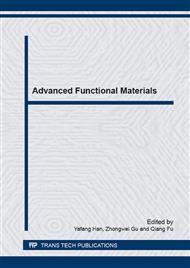[1]
C. Benvenuti, P. Chiggiato, F. Cicoira, V. Ruzinov, Decreasing surface outgassing by thin film getter coatings, Vacuum. 50 (1998) 57–63.
DOI: 10.1016/s0042-207x(98)00017-7
Google Scholar
[2]
P. Della Porta, Gas problem and gettering in sealed-off vacuum devices, Vacuum. 47 (1996)771–777.
DOI: 10.1016/0042-207x(96)00064-4
Google Scholar
[3]
R.M. Caloi, C. Carretti, Getters and gettering in plasma display panels, J. Vac. Sci. Technol.A. 16 (1998) 1991–(1996).
Google Scholar
[4]
P. A. Redhead, Hydrogen in vacuum systems; an Overview, AIP Conference Proceedings, 671(2003)243–254. (http: /adsabs. harvard. edu/abs/2003AIPC. 671. 243R).
Google Scholar
[5]
C. Boffito, E. Sartorio, An update of nonevaporable getters in electron-tubes, Vak. Tech. 35(1986) 212-217.
Google Scholar
[6]
K. Ichimura, K. Ashida, K. Watranabe, Contamination of ionization-chamber due to tritium exposure, J Vac. Sci. Technol. A. 3(1985) 346.
Google Scholar
[7]
S.M. Lee, Y.J. Park, H.Y. Lee, K.C. Kim, H.K. Baik, Hydrogen absorption properties of a Zr-Al alloy ball-milled with Ni powder, Intermetallics. 8 (2000) 781-784.
DOI: 10.1016/s0966-9795(00)00010-8
Google Scholar
[8]
Y. J. Yoon, K.W. Kim, H.K. Baik, S.W. Jang, S.M. Lee, Effects of catalytic surface layer on Zr-based alloy getters for hydrogen absorption, Thin Solid Films. 350 (1999) 138–142.
DOI: 10.1016/s0040-6090(99)00238-2
Google Scholar
[9]
C. Z. Liu, L.Q. Shi, Effect of alloying layer on hydrogen absorption ability of Zr-Al getter material, CHIN. PHYS. LETT. Vol. 21, No. 6 (2004) 1035.
DOI: 10.1088/0256-307x/21/6/015
Google Scholar
[10]
M. Prina, J.G. Kulleck, R.C. Bowman Jr, Assessment of Zr-V-Fe getter alloy for gas-gap heat switches, J. Alloys Compd. 330–332 (2002) 886–891.
DOI: 10.1016/s0925-8388(01)01522-5
Google Scholar
[11]
C. Benvenuti, P. Chiggiato, Obtention of pressures in the 10 torr range by means of a Zr-V-Fe non evaporable getter, Vacuum. 44 (1993) 511-513.
DOI: 10.1016/0042-207x(93)90084-n
Google Scholar
[12]
L. Rodrigo, J.A. Sawicki, Aging characteristics of Zr-V-Fe getters as observed by Mossbauer spectroscopy, J. Nucl. Mater. 265(1999) 208-212.
DOI: 10.1016/s0022-3115(98)00612-6
Google Scholar
[13]
B.G. Yang, National Standard of the People's Republic of China GB8763-88: TestMethods of Gas Absorption Characteristic for Non-Evaporation GetteringMaterials and Products, Standard Press of China, Beijing, 1988, p.392–395.
Google Scholar
[14]
P. Roupcová, O. Schneeweiss, Changes in phase composition of Zr–Fe–V getter after hydriding and vacuum dehydriding cycles, J. Alloys Compd. 492 (2010) 160–165.
DOI: 10.1016/j.jallcom.2009.11.147
Google Scholar
[15]
C. Boffito, F. Doni, L. Rosai, Gettering in cryogenic applications, J. Less-Common Metals. 104 (1984)149-157.
Google Scholar
[16]
C. Boffito, B. Ferrario, P. Della Porta,L. Rosai, A nonevaporable low temperature activatable getter material, J. Vac. Sci. Technol. 18(1981) 1117-1120.
DOI: 10.1116/1.570852
Google Scholar
[17]
B. Jackson, H. Metiu, The dynamics of H dissociation on Ni(100): A quantum mechanical study of a restricted two-dimensional model, J. Chem. Phys. 86 (1987) 1026-1035.
DOI: 10.1063/1.452337
Google Scholar
[18]
A.J. Cruz, B. Jackson, Mixed quantum classical studies of H2 dissociation on metals: Dependence upon molecular geometry and dimensionality, J. Chem. Phys. 94 (1991) 5715-5722.
DOI: 10.1063/1.460455
Google Scholar
[19]
J. Harris, S. Andersson, H2 Dissociation at Metal Surfaces, J. Phys. Rev. Lett. 55 (1985) 1583-1586.
Google Scholar
[20]
P.E.M. Siegbahn, M.R.A. Blomberg C.W. Bauschlicher, Jr., The dissociation of H2 on the Ni(100) surface, J. Chem. Phys. 81 (1984) 2103-2111.
Google Scholar
[21]
G. KressePhys. Dissociation and sticking of H2 on the Ni(111), (100), and(110) substrate, Rev. B 62 (2000) 8295-8305.
Google Scholar
[22]
P. Zhang, S.X. Wang, J. Zhao, C.H. He, P. Zhang, First-principles study of H2 adsorption and dissociation on Zr(0 0 0 1), J. Nucl. Mater. 418 (2011) 159-164.
DOI: 10.1016/j.jnucmat.2011.06.029
Google Scholar
[23]
J. Luo, H.B. Zhou, Y.L. Liu, L.J. Gui, S. Jin, Y. Zhang, G.H. Lu, Dissolution, diffusion and permeation behavior of hydrogen in vanadium: a first-principles investigation, J. Phys.: Condens. Matter. 23 (2011) 135501-135507.
DOI: 10.1088/0953-8984/23/13/135501
Google Scholar
[24]
E.V. Steen, P.V. Helden, A DFT study of hydrogen dissociation on CO- and C-precovered FE(100) surfaces, J. Phys. Chem. C. 114 (2010) 5932-5940.
DOI: 10.1021/jp909689a
Google Scholar
[25]
Y. H. Xiong, X. Y. Wei, G. R. Qin, P. Yuan, C.H. Mao, J. Du, Preparation and hydrogen sorption performance of a modified Zr-C getter, Vacuum 82 (2008) 737-741.
DOI: 10.1016/j.vacuum.2007.10.008
Google Scholar


